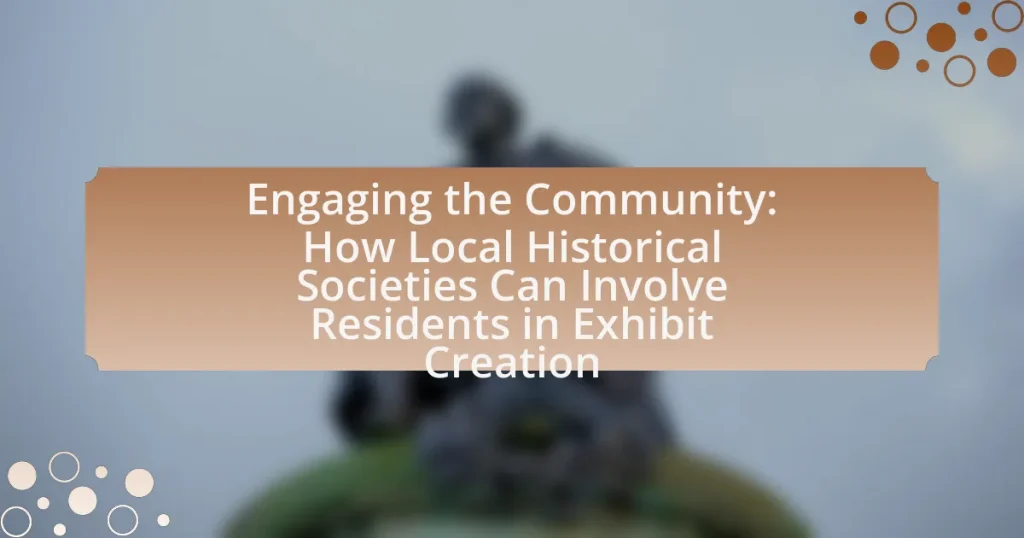Local historical societies are essential in fostering community engagement by connecting residents with their shared history through events, workshops, and exhibitions. These organizations actively involve community members in the creation of exhibits, enhancing local pride and social ties. The article explores various strategies employed by historical societies to attract participation, the importance of community involvement for preserving local heritage, and the benefits that arise from such engagement. Additionally, it addresses how demographic factors influence participation methods and highlights best practices for building lasting relationships with residents while overcoming common challenges in community engagement.
What is the role of local historical societies in community engagement?
Local historical societies play a crucial role in community engagement by fostering connections between residents and their shared history. These organizations often organize events, workshops, and exhibitions that encourage participation from community members, allowing them to contribute their own stories and artifacts. For instance, a study by the American Association for State and Local History found that local historical societies that actively involve residents in exhibit creation enhance community pride and strengthen social ties. By serving as a platform for dialogue and collaboration, local historical societies help preserve cultural heritage while promoting a sense of belonging among community members.
How do local historical societies foster community involvement?
Local historical societies foster community involvement by organizing events, educational programs, and collaborative projects that engage residents in preserving and sharing local history. These societies often host workshops, lectures, and exhibitions that invite community members to contribute their stories, artifacts, and knowledge, thereby creating a sense of ownership and pride in local heritage. For instance, a study by the American Association for State and Local History found that communities with active historical societies report higher levels of civic engagement and participation in local events, demonstrating the positive impact these organizations have on fostering a connected and informed community.
What strategies do they use to attract residents’ participation?
Local historical societies use various strategies to attract residents’ participation, including community outreach programs, interactive workshops, and collaborative projects. These initiatives encourage residents to share their stories and artifacts, fostering a sense of ownership and connection to local history. For example, societies often host open houses and informational sessions to inform residents about upcoming exhibits and invite their contributions. Additionally, partnerships with schools and local organizations enhance engagement by integrating history into educational curricula and community events, thereby increasing participation rates.
How do these strategies vary by community size and demographics?
Strategies for engaging communities in exhibit creation vary significantly based on community size and demographics. In larger communities, historical societies often employ diverse outreach methods, such as social media campaigns and public forums, to reach a broader audience, while smaller communities may rely on direct, personal interactions and local events to foster engagement. Additionally, demographic factors such as age, cultural background, and socioeconomic status influence the types of strategies used; for instance, younger demographics may respond better to digital engagement, whereas older populations might prefer traditional methods like workshops or community meetings. Research indicates that tailored approaches that consider these variables lead to higher participation rates and more meaningful contributions from residents.
Why is community involvement important for historical societies?
Community involvement is crucial for historical societies because it fosters a sense of ownership and connection to local heritage among residents. When community members actively participate in historical societies, they contribute unique perspectives and narratives that enrich the society’s exhibits and programs. This engagement not only enhances the authenticity of the historical representation but also encourages broader public interest and support for preservation efforts. Studies have shown that communities with active participation in historical initiatives experience increased civic pride and a stronger commitment to preserving their local history.
What benefits does community engagement bring to historical societies?
Community engagement brings numerous benefits to historical societies, including enhanced relevance and increased public support. By involving local residents in exhibit creation, historical societies can ensure that the narratives presented reflect the community’s diverse perspectives and experiences. This collaborative approach fosters a sense of ownership among community members, leading to greater attendance and participation in events. Research indicates that societies that actively engage their communities see a 30% increase in visitor numbers and a 25% rise in membership, demonstrating the tangible impact of such involvement.
How does community involvement enhance the preservation of local history?
Community involvement enhances the preservation of local history by fostering a sense of ownership and connection among residents. When individuals actively participate in historical projects, such as archiving documents or organizing events, they contribute unique perspectives and knowledge that enrich the historical narrative. For instance, local historical societies that engage community members often gather oral histories, which provide firsthand accounts and details that may not be documented elsewhere. This collaborative effort not only preserves artifacts and stories but also encourages ongoing interest and investment in local heritage, ensuring that history remains relevant and accessible to future generations.
How can residents contribute to exhibit creation in local historical societies?
Residents can contribute to exhibit creation in local historical societies by sharing personal artifacts, stories, and historical knowledge. This involvement enriches the exhibits with authentic local narratives and tangible items that reflect the community’s heritage. For instance, residents can donate photographs, letters, or objects that hold historical significance, which can be displayed to provide context and depth to the exhibits. Additionally, community members can participate in planning and curating exhibits, offering insights that ensure the displays resonate with local history and culture. Engaging residents in workshops or focus groups can also facilitate collaborative efforts in exhibit design, fostering a sense of ownership and pride in the local history.
What types of contributions can residents make?
Residents can contribute to local historical societies by providing artifacts, sharing personal stories, and volunteering for events. Artifacts can include items of historical significance that reflect the community’s heritage, while personal stories can offer unique perspectives and context to exhibits. Additionally, volunteering for events helps in organizing and promoting activities that engage the community, fostering a collaborative environment for historical preservation. These contributions enhance the richness of exhibits and strengthen community ties.
How can residents share their personal stories and artifacts?
Residents can share their personal stories and artifacts through organized community events, such as storytelling sessions, workshops, and exhibitions hosted by local historical societies. These platforms encourage participation by allowing individuals to present their narratives and display their items, fostering a sense of community engagement and preserving local history. Historical societies often facilitate these interactions by providing resources, guidance, and promotional support to ensure that residents feel empowered to contribute their unique experiences and artifacts.
What skills can residents offer to assist in exhibit development?
Residents can offer a variety of skills to assist in exhibit development, including research, storytelling, and community engagement. Research skills enable residents to gather historical data and personal narratives that enrich the exhibit’s content. Storytelling abilities help in crafting compelling narratives that connect visitors emotionally to the exhibits. Additionally, community engagement skills facilitate collaboration with local organizations and individuals, ensuring that the exhibits reflect the community’s diverse perspectives and histories. These contributions enhance the authenticity and relevance of the exhibits, making them more impactful for visitors.
How do local historical societies facilitate resident contributions?
Local historical societies facilitate resident contributions by creating platforms for community engagement and collaboration. They organize events such as workshops, lectures, and volunteer opportunities that encourage residents to share their knowledge, artifacts, and stories. For instance, many societies host open calls for local history submissions, allowing residents to contribute personal narratives or historical documents, which enrich the society’s collections and exhibits. Additionally, societies often provide training and resources for residents to participate in research and exhibit development, fostering a sense of ownership and pride in local heritage. This collaborative approach not only enhances the historical society’s offerings but also strengthens community ties and promotes a shared understanding of local history.
What programs or workshops are available for residents to participate in?
Local historical societies offer various programs and workshops for residents to engage in exhibit creation. These include hands-on workshops focused on historical research methods, artifact preservation techniques, and storytelling sessions that help residents share their personal histories. Additionally, societies may host community meetings to gather input on exhibit themes and content, fostering collaboration between residents and historians. Such initiatives not only enhance community involvement but also enrich the historical narrative presented in local exhibits.
How do societies ensure that contributions are valued and recognized?
Societies ensure that contributions are valued and recognized through formal acknowledgment systems, community engagement initiatives, and public displays of appreciation. For instance, local historical societies often host events where contributors are celebrated, such as award ceremonies or community gatherings, which publicly highlight their efforts. Additionally, societies may create plaques, certificates, or digital platforms that showcase individual contributions, thereby providing tangible recognition. Research indicates that recognition fosters a sense of belonging and encourages further participation, as seen in studies on community engagement that demonstrate increased volunteerism when contributions are publicly acknowledged.
What are effective methods for engaging residents in the exhibit creation process?
Effective methods for engaging residents in the exhibit creation process include collaborative workshops, community surveys, and participatory design sessions. Collaborative workshops allow residents to share their stories and ideas, fostering a sense of ownership and connection to the exhibit. Community surveys can gather input on topics of interest, ensuring that the exhibit reflects the community’s values and history. Participatory design sessions enable residents to contribute directly to the layout and content of the exhibit, enhancing their investment in the final product. These methods have been shown to increase community involvement and satisfaction, as evidenced by successful projects in various local historical societies that have implemented similar strategies.
How can historical societies use technology to engage residents?
Historical societies can use technology to engage residents by implementing interactive digital platforms that facilitate participation in exhibit creation. For instance, online surveys and social media campaigns allow residents to share their stories and artifacts, fostering a sense of ownership and connection to local history. Additionally, virtual reality experiences can immerse residents in historical events, enhancing their understanding and appreciation of the community’s heritage. Studies show that communities with active digital engagement see increased participation in local events and a stronger sense of community identity.
What digital platforms can be utilized for collaboration and feedback?
Digital platforms that can be utilized for collaboration and feedback include Slack, Microsoft Teams, Google Workspace, Trello, and Zoom. These platforms facilitate real-time communication, document sharing, and project management, which are essential for collaborative efforts. For instance, Slack allows for organized discussions through channels, while Microsoft Teams integrates with Office applications for seamless collaboration. Google Workspace offers tools like Google Docs for simultaneous editing and feedback. Trello provides a visual project management system that helps track tasks and progress, and Zoom enables virtual meetings for discussions and feedback sessions. Each of these platforms has been widely adopted in various sectors, demonstrating their effectiveness in enhancing collaboration and gathering feedback.
How can social media enhance community engagement in exhibit creation?
Social media enhances community engagement in exhibit creation by providing platforms for collaboration, feedback, and promotion. These platforms allow local historical societies to connect with residents, encouraging them to share their stories, artifacts, and ideas, which can be integrated into exhibits. For instance, a study by the Pew Research Center found that 69% of adults in the U.S. use social media, indicating a broad audience that can be reached for input and participation. Additionally, social media facilitates real-time communication, enabling societies to gather insights and suggestions quickly, thus fostering a sense of ownership and involvement among community members in the exhibit development process.
What role do events and activities play in engaging the community?
Events and activities serve as vital tools for engaging the community by fostering participation, building relationships, and enhancing local identity. They create opportunities for residents to connect with one another and with their local historical societies, promoting a sense of belonging and shared purpose. For instance, community events such as workshops, exhibitions, and festivals encourage collaboration and dialogue among participants, which can lead to increased civic involvement. Research indicates that communities with active engagement through events experience higher levels of social cohesion and trust, as evidenced by studies showing that neighborhoods with regular community activities report greater satisfaction and lower crime rates.
How can historical societies organize events that encourage participation?
Historical societies can organize events that encourage participation by creating interactive and inclusive programs that engage community members. These programs can include hands-on workshops, guided tours, and collaborative projects that invite residents to contribute their own stories and artifacts. For instance, a historical society might host a community day where locals can bring personal items related to the town’s history, fostering a sense of ownership and connection to the past. Research indicates that participatory events increase community engagement, as seen in studies showing that local history projects involving residents lead to higher attendance and involvement rates.
What types of activities can be designed to involve residents in exhibits?
Activities designed to involve residents in exhibits include workshops, community brainstorming sessions, and interactive storytelling events. Workshops allow residents to contribute their skills, such as crafting or research, directly to the exhibit’s development. Community brainstorming sessions encourage collective input on themes and content, fostering a sense of ownership among participants. Interactive storytelling events invite residents to share personal narratives related to the exhibit’s subject, enriching the exhibit with diverse perspectives. These activities not only enhance community engagement but also ensure that the exhibits reflect the local culture and history accurately.
What best practices should local historical societies follow for successful engagement?
Local historical societies should prioritize community involvement, transparency, and educational outreach for successful engagement. Engaging residents in the planning and creation of exhibits fosters a sense of ownership and connection to local history. Societies can achieve this by hosting workshops, soliciting input through surveys, and collaborating with local schools and organizations. Research indicates that participatory approaches increase community interest and attendance, as seen in the case of the San Francisco Museum of Modern Art, which reported a 30% increase in visitor engagement after implementing community-driven projects. By actively involving residents, historical societies can create relevant and meaningful exhibits that resonate with the community.
How can societies build lasting relationships with community members?
Societies can build lasting relationships with community members by actively involving them in decision-making processes and collaborative projects. Engaging residents in the creation of exhibits fosters a sense of ownership and belonging, which strengthens community ties. For instance, local historical societies that invite community input on exhibit themes and content not only enhance the relevance of their displays but also encourage participation, as seen in successful initiatives like the “Community Curators” program in various museums. This approach has been shown to increase visitor engagement and satisfaction, leading to a more connected and invested community.
What common challenges do societies face in engaging residents, and how can they overcome them?
Societies commonly face challenges such as lack of awareness, limited resources, and diverse resident interests when engaging residents. To overcome these challenges, societies can implement targeted outreach programs to raise awareness, seek partnerships for resource sharing, and conduct surveys to understand and address the varied interests of residents. For instance, a study by the National Endowment for the Arts found that community engagement initiatives that include resident input significantly increase participation rates, demonstrating the effectiveness of these strategies.















